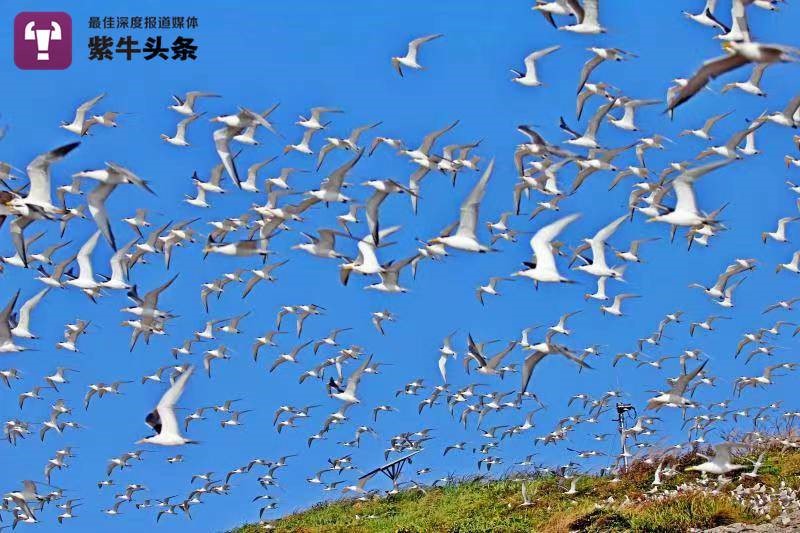Young man spends 10 years on uninhabited islet protecting “birds of myth”
A small island lying on the East China Sea, with an area of only 0.02 square kilometers, has caught the world’s attention. Named Zhongtiedun Islet, it is home to a flock of Chinese crested terns, hailed as “birds of myth”, which disappeared from sight for nearly 63 years.
Ding Peng is one of the guardians of these precious birds. Since 2013, he has stayed on the islet for over 100 days every year. Thanks to the concerted efforts of Ding and other volunteers, the number of Chinese crested terns in the area, during a span of 10 years, has increased from 19 in the first year to more than 100 today.
Ding, 33, comes from Lanzhou city, capital of northwest China's Gansu Province. Familiar with barren mountains and the rolling sandstorms in his childhood, he has developed an awareness of environmental protection since a young age. After graduation, Ding began to work at a national nature reserve in Xiangshan county, Ningbo city, east China’s Zhejiang Province, where he offered to take part in the Chinese crested tern’s attraction and restoration monitoring project.

A Chinese crested tern hovers in the air. (Photo provided by the interviewee)
The Chinese crested tern, a medium-sized waterfowl, is under first-class state protection in China. The bird is 30 to 40 centimeters in length, with a black tip, grey mantle and white rump. It was first discovered by scholars in 1861, while its last trace was recorded in 1937. It was believed to be extinct.
Back in 2000, a bird photographer spotted several black-billed terns amid a group of greater crested terns on the Matsu Islands. These unfamiliar birds were finally identified as Chinese crested terns after multiple rounds of verification.
More and more people have participated in the search, observation and protection of this rare species since then. Ornithologists found it on the Jiushan Islands, Zhejiang Province, between 2004 and 2007. According to official data, its total population in the world stood at less than 30 at that time, categorized as a critically endangered species by the International Union for Conservation of Nature (IUCN).
Ding, with over 30 domestic and foreign experts, visited the Zhongtiedun Islet in Ningbo in March 2013. They intended to select a breeding habitat, artificially guiding the bird to the targeted area, in order to further help its chances of increasing in numbers.

Ding Peng stays with groups of terns. (Photo provided by the interviewee)
At the beginning, there were no Chinese crested terns on the islet, so Ding’s mission was to lead these “birds of myth” to inhabit it. “It’s amazing. The attraction efforts paid off in the very first year,” the young man was excited when talking about his initial monitoring experience. “Based on overseas experience, it generally takes three to five years to attract birds successfully, even for those of a large population.”
This kind of terns, in most cases, give birth to baby birds between May and August. They prefer to lay eggs on barren islands, which explains why experts chose the flat Zhongtiedun Islet as a designated habitat. The islet saw a series of adjustments, including removing higher bushes, putting in place 400 similarly-sized bird models and simulating courtship sounds via a playback sound system.
Ding, together with an American volunteer, started their long-term monitoring on the small island in May 2013. To avoid human activities' influence on birds, they set the observation site on the Jigushan Islet, opposite the Zhongtiedun Islet. Unfortunately, no Chinese crested terns were spotted even after two months. “Experts suggested moving all equipment out of the islet and adjusting the plan in the next year, because the breeding season was over. The American volunteer also returned to his country,” Ding said.
However, the next day proved to be a turning point. “When I was packing, I suddenly caught sight of over 50 greater crested terns. I felt a glimmer of hope, because Chinese crested terns and greater crested terns often co-occur.”

Flocks of terns soar in the azure sky. (Photo provided by the interviewee)
Two days later, Ding decided to recheck the situation on the islet by boat. “As the boat was approaching one corner of the islet, around 2,000 to 3,000 greater crested terns were found hovering in the air, among which there are Chinese crested terns.” Ding was fully astonished by the scene, “It is well worth the two-month-plus stay.”
This rare bird settled down on the small island, following the first successful attraction. A growing number of Chinese crested terns continue to pay their yearly visit and thrive here. The observation site was moved onto the Zhongtiedun Islet in 2014, where Ding would spend several months each year, carefully recording the changes of the species’ population year after year.
The number of observed adult birds registered 93, which reproduced 36 nests of baby birds this year. Both set the new world record.
The Zhongtiedun Islet has become the largest breeding habitat of Chinese crested terns since the artificial attraction project kicked off, Ding proudly said. The population of baby birds hatched here is more than 150 at least, accounting for over 80 percent of the world’s total.
The young guardian at first worked and lived in a tent on the islet. His daily routine ranges from filming terns and taking notes through camera and computer, to protecting them from getting wounded by people and other animals.
The life on the island basically relies on Ding’s own strength. “The electricity was initially supplied by a solar panel. However, when the rainy season arrives, the stored power could only support a phone,” Ding added, “Besides, it’s burning hot during summer. There’s no air conditioner, and I’m unable to take a shower.”

Ding Peng reads books in front of a tent. (Photo provided by the interviewee)
Compared with tough living conditions, the biggest challenge rises from loneliness. “There are only two people on the island in most cases, which means you could just look at the same face every day,” Ding explained. Days before the arrival of terns are the most trying ones. To relieve the boredom, he brought many books.
Fully realizing the significance of what he has engaged in, Ding is still on this way with great enthusiasm. The result is encouraging, making him have no regrets about his choice. Terns bred here fly to different corners of the world, applauded by birdwatchers and photographers.
The success of Chinese crested tern’s attraction and restoration monitoring project is closely followed by the world. The project recruits volunteers to work on the islet each year. “It was enthusiastically responded, and many volunteers hold master’s or doctor’s degrees of relevant disciplines,” Ding said.
Ding also teaches himself to take photos, considering the needs of his job. Many valuable moments of this “bird of myth” are captured by his camera. Flocks of Chinese crested terns soar in the azure sky, forming a stunning picture, which is admired by many as “the real harmony between humanity and nature”.
Photos
Related Stories
Copyright © 2022 People's Daily Online. All Rights Reserved.









